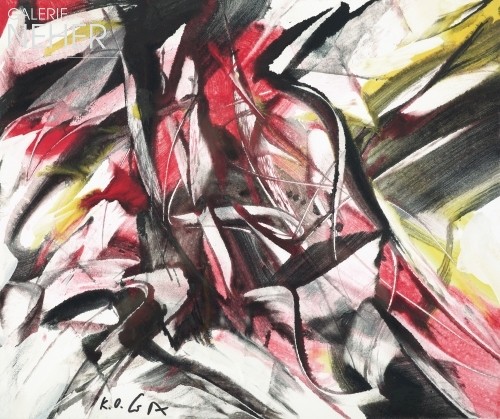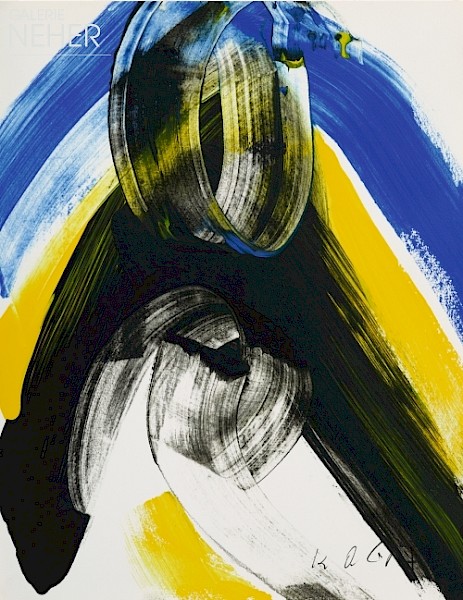Karl Otto Götz
* 22 02 1914 | Aachen
† 19 08 2017 | Wolfenacker
Karl Otto Götz is considered one of the most important pioneers and representatives of German Informalism. His work was of great importance for the international development of art after 1945. Many important artists also originated from his class as professor at the Kunstakademie Düsseldorf, including Bernhard Blume, Kuno Gonschior, Gotthard Graubner, Sigmar Polke, Gerhard Richter, Rissa, HA Schult, Paul Schwietzke and Franz Erhard Walther.
Works by Karl Otto Götz
Vita Karl Otto Götz
1914
Born on 22 February in Aachen.
1926
Friendship with the later painter and graphic artist Erich Mueller-Kraus, which provides him with artistic motivation.
1930
Götz joins the academic flying group of the Technische Hochschule in Aachen.
1932
He leaves the flying group and attends the Höhere Webeschule (higher weaving school) in Aachen. There he meets his future wife, Anneliese Brauckmeyer. He simultaneously begins studies at the Kunstgewerbeschule (school of applied arts), where he receives lessons in still life and nude drawing.
1933
The Kunstgewerbeschule is closed. Götz accepts a trainee position as a draughtsman in a Düren carpet factory.
1935
First Spritzbilder (spray paintings). Götz is prohibited from painting and exhibiting after mistakenly submitting one of his experimental paintings to the Reich Chamber of Culture.
1936
Further experiments with spray technique, as well as with abstract films, photo painting and photograms. He establishes contact with the British author Herbert Read, with whom he maintains a stimulating correspondence.
At the end of the year he is called up for two years of military service with the Luftwaffe (air force) in Gütersloh.
1939–40
Military service in Nordhausen in the Harz Mountains, where he trains young recruits in telephone and telegraph construction.
1940
His unit is transferred to Dresden. He meets Otto Dix and the gallery owner Heinrich Kühl, who becomes his first art dealer.
1941
The first Luftpumpenbilder (air pump paintings), in addition to oil and tempera paintings.
Götz is transferred to Norway as a fighter controller. Granted leave of absence for a study semester at the Dresden Kunstakademie. He becomes friends with the art author Will Grohmann and establishes contact with Willi Baumeister, with whom he remains friends until Baumeister’s death in 1955.
1942
Return to Norway. In the following years he produces drawings for his Fakturenfibel (facture manual), which he is forced to leave behind upon departure and which is only returned to him in the mid-1960s.
1945
His apartment and large parts of the early work are destroyed in the bombing of Dresden on 13 and 14 February.
Götz is able to avoid becoming a prisoner of war thanks to the intervention of Herbert Read.
He lives with Anneliese Brauckmeyer and her children on a farm in Königsförde near Hameln. The couple marries in December.
1946
First solo exhibition in Studio Rasch in Wuppertal.
Birth of their son Alexander Götz.
1947
He works on gouaches, tempera paintings and monotypes. Götz establishes contact with the artists of the CoBrA group through the British cultural protection officer and painter Major William Gear. He becomes a member of the association.
1948
He is awarded the Junger Westen art prize. He publishes the magazine for experimental art and poetry, Metamorphose, later META. The monograph entitled Karl Otto Götz. Malerei und Graphik 1941–43 by Will Grohmann appears.
1949
He participates As the only German in the first major CoBrA exhibition in Amsterdam and becomes the editor of the German edition of the magazine Cobra 5.
1950
Move to Frankfurt am Main; he maintains intensive contact with artists and writers from throughout Europe. First trips to Paris follow, where he meets Hans Hartung in the same year.
1951
Participation in the second major CoBrA exhibition in Lüttich. He meets Paul Celan and publishes two of his poems in META 8 as the first in Germany.
1952
He paints his last oil painting, subsequently dedicating himself to a new painting technique with paste, gouache, brush and rake.
Founding of the Quadriga artist group together with Otto Greis, Heinz Kreutz and Bernard Schultze; first exhibition of the association in the Zimmergalerie Franck in November.
1954
Solo exhibition in the Paris gallery Raymond Creuze. First solo exhibition in the USA in October in the gallery of Zoe Dusanne in Seattle.
1955
Westfälischer Kritikerpreis (Westphalian critics’ prize). Participation in many international exhibitions.
1957
Informalism receives official recognition with the first major exhibitions throughout Germany.
1957–60
Cooperation with the Galerie 22 in Düsseldorf, founded by Jean Pierre Wilhelm.
1958
Participation in the 29th Biennale di Venezia. First lithographic works.
Appointment to the Kunstakademie Düsseldorf in the autumn, where he takes over the Free Painting class in April 1959 and is active as a professor until 1979.
He buys a small house in Norway, in which he stays every year until 1999. Norwegian titles and titles composed of made-up words find their way into his work.
1959
Participation in the 2nd documenta in Kassel. Commences with work on Rasterbildern (grid paintings) against the background of examinations relating to information theory.
Resettlement to Düsseldorf. Encounter with John Cage and Nam Jun Paik in Galerie 22.
1960
Meets Karin Martin, who becomes his student and later becomes known as a painter under the name Rissa.
1962
The grid film Density 10:3:2:1 of Götz and Rissa also stimulates Nam Jun Paik to experiments with television images at the beginning of the 1960s.
1962–66
Cooperation with the stone printer H.P. Alvermann in Düsseldorf.
1964
Major solo exhibition in the Palais des Beaux-Arts in Brussels.
1965
Divorce from his first wife and marriage with Rissa.
1967
Solo exhibition in the Suermondt-Museum in Aachen.
1968
Participation in the 34th Biennale di Venezia.
1969
Solo exhibition in the Kunsthalle Mannheim.
1972
Karl Otto and Karin Götz publish the book Probleme der Bildästhetik. Eine Einführung in die Grundlagen des anschaulichen Denkens.
1974
Withdrawal from the Senate of the Düsseldorf Akademie.
1975
Move to Niederbreitbach/Wolfenacker in the Westerwald mountain range.
1978/79
Paintings created without the use of a rake.
1982
Informalism symposium i in the Saarlandmuseum Saarbrucken. In addition to Götz, Gerhard Hoehme, Bernard Schultze, K.R.H. Sonderburg and Fred Thieler also participate.
1984
The two-volume autobiography Erinnerungen und Werk appears.
1984/85
Major retrospectives in the Kunsthalle Düsseldorf, the Saarlandmuseum Saarbrucken and the gallery of the city of Esslingen (Villa Merkel).
1986
Paintings of the Giverny series produced, in which the artist dispenses with black and uses pure colours.
1988
Retrospective in the Kunstverein Braunschweig (art association).
1989
Order of Merit from the State of North Rhine-Westphalia.
1994
Retrospective in the Staatliche Kunstsammlungen Dresden on the occasion of his 80th birthday.
1995
Design and execution of glass windows for the Städtische Kunstsammlungen Chemnitz. First ceramic works.
1996
State prize for painting of the Federal State of Rhineland-Palatinate.
1997
Founding of the K.O. Götz und Rissa-Stiftung (foundation).
2000
Awarded the ring of honour of the City of Aachen. First steel reliefs.
2003
Start of the Holzvögel (wooden bird) series.
2004
Major exhibitions on the occasion of his 90th birthday, including in the MKM Museum Küppersmühle in Duisburg, the Suermondt-Ludwig Museum and the Ludwig Forum Aachen, as well as in the Saarlandmuseum Saarbrucken.
2005
The last lithographs are produced.
2007
The Villa Hammerschmidt in Bonn is decorated with paintings by Götz and Bernard Schultze. He is awarded the Federal Cross of Merit, First Class.
2009
Rissa and K.O. Götz are awarded the Order of Merit of the Federal State of North Rhine-Westphalia.
2010
Retrospective in the Museum Bahnhof Rolandseck in Remagen. Awarded the honorary doctorate of the University of Fine Arts Münster.
2013/14
Major solo exhibition in the Nationalgalerie, Berlin, the MKM Museum Küppersmühle, Duisburg and the Museum Wiesbaden.
2014
The Werkverzeichnis der Gemälde (catalogue raisonné of the paintings) by Ina Ströher is published.
2017
Götz passes away on 19 August in Wolfenacker.
The early work
A look at the early work of the young Götz reveals an involvement with the language of form of Expressionist and Surrealist role models like Wassily Kandinsky, Paul Klee, Max Ernst and Juan Gris. However, the works of Willi Baumeister also had an inspiring effect on his work for a time. First abstract works already appeared in 1933, and in 1935 Götz produced Spritzbilder (spray paintings) with imagined figures and bird creatures with the help of templates placed upon one another, accompanied by experiments with abstract films, photograms and photo paintings. The Luftpumpenbilder (air pump paintings), in which he applied watercolour by atomising it onto the surface with an air pump, appear as of 1941. In 1944/45, he worked in Norway on his Fakturenfibel and developed his own codex of form in them.
K.O. Götz in Paris
As of 1950, the artist stayed regularly, not seldom together with his friend Bernard Schultze, in Paris, where he became familiar with works by Wols, Hans Hartung, Georges Mathieu, Jean Fautrier, but also with works of the American Willem de Kooning. He is himself especially interested in spontaneous, gestural painting. He painted his initially last oil painting on canvas in September 1952.
Informalism
He had previously quite spontaneously made the discovery when stirring wallpaper paste that this material, overlapped with gouache paint applied with the brush and immediately processed with the rake, fulfilled his wish for a rapid, impulsive manner of painting. In this way, image areas from the foreground and background permeated one another positively and negatively, resulting in dynamic pictorial schemata, spirited spirals of colour and the complete abrogation of representational reminiscences. With his paintings and gouaches, initially still in colour, later preferably in black and white, Götz became an internationally recognised representative of Informalism.
The triptych UDZ (Unter diesem Zeichen), and thus K.O. Götz’ first artistic-political statement, originated in 1958. The painter made a statement against nuclear war with the black-red crucifix form in the middle section, with its Christian associations, and the flanking Jupiter and Matador paintings (names of US atomic missiles stationed in West Germany).
From 1960–62, he worked together with his later wife Rissa on the grid film Density 10:3:2:1, one of the first experimental abstract films.
The Jonction and Giverny series
In 1977, another politically motivated work was produced with Moga, a reference to RAF terror in Mogadishu, followed in 1990/91 by the Jonction series, which was inspired by German reunification. Intensely colourful painting found its way into the oeuvre of K.O. Götz in the 1980s with the paintings of the Giverny series. Pure colours in radiant shades full of light now dominated his paintings and are reminiscent of the famous paintings from the oeuvre of his predecessor Claude Monet.
The late work
In the late work, the painter now once again turned to new techniques, materials and experiments. He dedicated himself to ceramic works as of 1995. Forty large-format, steel sculptures were produced as of 2000, and the Holzvögel painted with informal forms as of 2003. Also noteworthy are the Luminografien (Luminographs) of 2003, a series of light drawings carried out with a flashlight.
However, the aged artist also once again blazed new trails in painting with monumental paintings in black and white. The rake now measured almost a metre and was drawn with dynamic swings in gigantic dimensions over the canvas.
With large-format, informal history paintings, K.O. Götz once again addressed political themes and current events in the 2000s: thus, for example, the collapse of the World Trade Center in 2001, the tsunami disaster of 2004 or the bombing attacks on Dresden on the occasion of their 60th anniversary in 2005.

